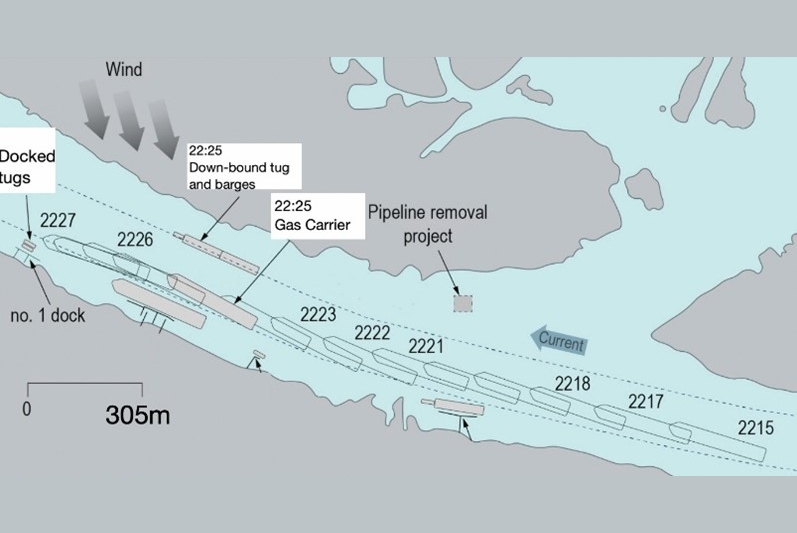Be mindful of accumulating “risk multipliers” and act conservatively, says The Nautical Institute in its latest Mars Report in which it discusses an LPG carrier colliding with a berthed tug. A following current, winds and darkness all contributed to this accident.
The Nautical Institute gathers reports of maritime accidents and near-misses. It then publishes these so-called Mars Reports (anonymously) to prevent other accidents from happening. A summary of this incident:
An LPG carrier in ballast was being piloted up a narrow waterway in darkness to the loading berth with one tug escort secured astern. The pilot reduced the vessel’s speed to minimise the wake before passing a pipeline removal project that was outside but close to the navigation channel.
Once clear of the pipeline removal project, the pilot requested the escort tug astern to give full thrust to help get past a ship docked to port. A down-bound tug pushing barges, which was near the northern limit of the channel, passed the gas carrier starboard to starboard.
At the time, the following current was about 0.4 knots (flood current). With the wind about 25 knots off the gas carrier’s starboard side, the pilot now issued multiple rudder orders, and a half-ahead propulsion order, as well as an order to the tug to ‘get the stern out’. The gas carrier was still very close to the channel’s southern limit, making a speed of 4.1 knots.

About one minute later, as the gas carrier passed the moored vessel closely to port, the pilot ordered five short blasts of the ship’s whistle, and requested the escort tug to give full thrust as well as various engine and helm orders. The gas carrier’s bow was now moving toward some tugs moored at dock number 1 (far left of diagram), so the starboard anchor was released and engine emergency full astern was requested.
Notwithstanding these last desperate actions the gas carrier’s port bow collided with a berthed tug at dock number 1. Combined damage to the moored tugs and the dock were in the order of USD 1 million.
Also read: Fog and single-point failure lead to allision with bridge support
Investigation findings
Although the US National Transportation Safety Board (NTSB) found that the ‘probable cause’ of the collision was the low speed of the gas carrier causing a loss of rudder effectiveness in strong crosswinds, other factors also contributed.
For example, downbound traffic made for less space at a critical juncture in the narrow waterway. The escort tug secured astern could not effectively help the gas carrier’s bow come away from the berthed tugs at a critical instance.
Another factor was the darkness, which affects visual perception, acuity and depth of field. This in turn affects a person’s responses and timing during manoeuvres.
Finally, a following current will adversely affect a manoeuvre making a vessel’s speed through the water less than its speed over the ground, thus inherently less manoeuvrable.
Also read: Tug order mix-up leads to allision and shore crane collapse
Advice from The Nautical Institute
- It is often said that hindsight is 20:20. In this case we can see, after the fact, that given the winds and current, a meeting with the tug and barges may have been safer at a spot other than abeam the docked vessel.
- Factors that negatively affect a situation are not always evident at first, but as the situation develops, they become risk multipliers. In this case, darkness was a pre-existing negative factor. Combined with the winds, the following current, the vessel’s slow speed to accommodate the pipeline removal project and the down-bound traffic at a critical juncture made for an almost untenable situation.
- In restricted waterways manoeuvres, it is an advantage that our foresight be as acute as our hindsight. Be mindful of accumulating “risk multipliers” and act conservatively.
Also read: Bridge resource management gone wrong: VLCC hits buoy and almost collides with anchored ship
Mars Reports
This accident was covered in the Mars Reports, originally published as Mars 202306, that are part of Report Number 364. A selection of this Mars Report was also published in SWZ|Maritime’s March 2023 issue. The Nautical Institute compiles these reports to help prevent maritime accidents. That is why they are also published (in full) on SWZ|Maritime’s website.
More reports are needed to keep the scheme interesting and informative. All reports are read only by the Mars coordinator and are treated in the strictest confidence. To submit a report, please use the Mars report form.








